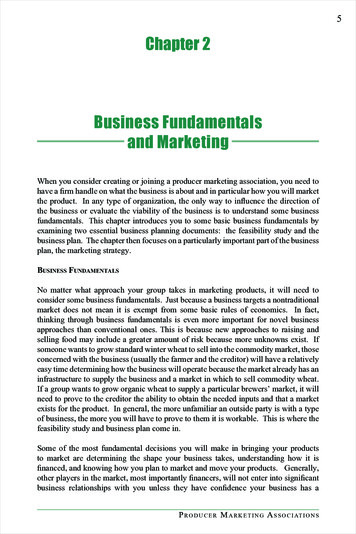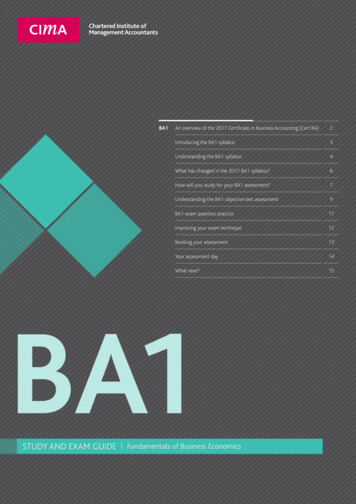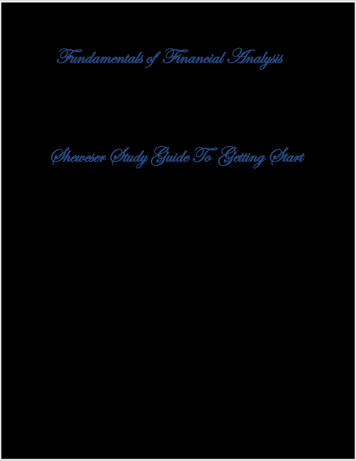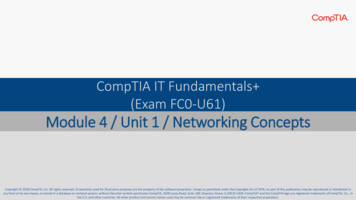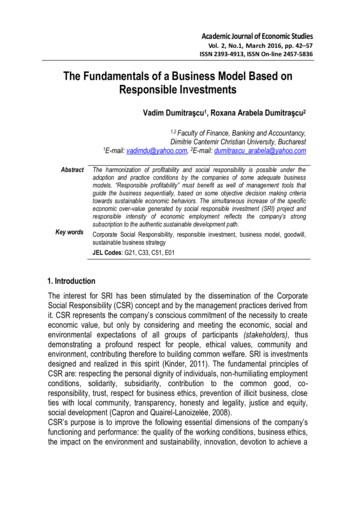
Transcription
Academic Journal of Economic StudiesVol. 2, No.1, March 2016, pp. 42–57ISSN 2393-4913, ISSN On-line 2457-5836The Fundamentals of a Business Model Based onResponsible InvestmentsVadim Dumitraşcu1, Roxana Arabela Dumitraşcu21,2 Facultyof Finance, Banking and Accountancy,Dimitrie Cantemir Christian University, Bucharest1E-mail: vadimdu@yahoo.com, 2E-mail: dumitrascu arabela@yahoo.comAbstractKey wordsThe harmonization of profitability and social responsibility is possible under theadoption and practice conditions by the companies of some adequate businessmodels. “Responsible profitability” must benefit as well of management tools thatguide the business sequentially, based on some objective decision making criteriatowards sustainable economic behaviors. The simultaneous increase of the specificeconomic over-value generated by social responsible investment (SRI) project andresponsible intensity of economic employment reflects the company’s strongsubscription to the authentic sustainable development path.Corporate Social Responsibility, responsible investment, business model, goodwill,sustainable business strategyJEL Codes: G21, C33, C51, E011. IntroductionThe interest for SRI has been stimulated by the dissemination of the CorporateSocial Responsibility (CSR) concept and by the management practices derived fromit. CSR represents the company’s conscious commitment of the necessity to createeconomic value, but only by considering and meeting the economic, social andenvironmental expectations of all groups of participants (stakeholders), thusdemonstrating a profound respect for people, ethical values, community andenvironment, contributing therefore to building common welfare. SRI is investmentsdesigned and realized in this spirit (Kinder, 2011). The fundamental principles ofCSR are: respecting the personal dignity of individuals, non-humiliating employmentconditions, solidarity, subsidiarity, contribution to the common good, coresponsibility, trust, respect for business ethics, prevention of illicit business, closeties with local community, transparency, honesty and legality, justice and equity,social development (Capron and Quairel-Lanoizelée, 2008).CSR’s purpose is to improve the following essential dimensions of the company’sfunctioning and performance: the quality of the working conditions, business ethics,the impact on the environment and sustainability, innovation, devotion to achieve a
The Fundamentals of a Business Model Based on Responsible Investments, VadimDumitraşcu, Roxana Arabela Dumitraşcupositive reputation in the context of the local community, improving the marketingsolutions in order to promote fair trade practices, cooperation for development,humanitarian actions and volunteering (Norris and Dwyer, 2014).The organic integration of CSR’s principles in the company’s management systemtargets decisions and actions in the following areas of great interest:1. The relationship between CSR and the business strategy (company’s mission,vision and values as an expression of CSR; organizing a CSR department withinthe organizational structure; including the CSR problematics in the ManagementBoard’s priorities; the use of a Responsible Conduct Code; the implementation of asystem of incentives for responsible behaviors; the introduction of a an integralbalanced scorecard that includes CSR criteria);2. Managing the groups of intererests (extending CSR from considering the opinionsand needs of the shareholders, employees and clients to incorporating theperspectives of the unions, communities, lobby and local actions groups, publicauthorities etc.);3. Technical and economic management (applying the triple results account, whichexpresses not only the economic parameters of the company’s functioning, but alsothe environmental and social ones);4. Corporate Governance (the existence of a good governance code; riskmanagement based on ethical, environmental, social and economic criteria;publishing some Reports concerning good governance);5. Social management policies (policy in human resources field and assimilation ofCSR principles in HR practices; the quality of the working environment; work safety;respect for human rights; integration of disabled people and representatives ofethnic minorities; form, develop and manage skills; involving the employees inrespecting and promoting the CSR criteria; reconciling the professional activity withfamily values; extra-salary financial stimuli; various support services offered toemployees);6. Environmental management and sustainability (correlation between company’senvironmental management and the lifecycle of the main products and technologies;systems and procedures to save consumption of the main resources (electricity,water, paper etc.); programs to reduce polluting residues and eco-efficiencyincrease; obtaining green certificates).Lately, the external monitoring of CSR practices at companies’ level spreadfollowing the increased interest of investors and markets to guide the managementpolicies in accordance with the requirements of sustainability. In this regard, themost known tools to ensure conformity at international level are: GRI (GlobalReporting Initiative); Social Accountability Standard 8000; Standard Accountability1000 (AA-100); ISO 26000 concernign social responsibility etc.43
Academic Journal of Economic StudiesVol. 2 (1), pp. 42–57, 2016 AJES2. Literature reviewThe economic factor differentiates between the socially responsible investment(SRI) and an altruistic activity, as it maintains the financial criteria associated withthe cost-effectiveness idea, which are considered legitimate and are pursued as wellwithin the investment approach. Currently, to the environmental and socialconsiderations those originating from the corporate governance area have beenadded, together constituting a coherent system of behavioral restrictions, known asthe ESG factors or criteria (in English, E stands for the word environment, S forsocial and G for corporative governance). SRI is not donations, sponsorships orvarious acts of philanthropy, but lucrative activities, mainly oriented towardsgenerating a flow of economic results. Related to this aspect, a vivid polemics hasspread lately concerning whether SRI is more convenient or not from a financialpoint of view than conventional investments. Consequently, three hypothesisconcerning SRI cost-effectiveness took shape (Wu, 2009): „No effect“, meaning that SRI cost-effectiveness is similar to that of conventionalinvestments; „Doing good but not so well“, sustains that SRI cost-effectiveness is lower thanthat of conventional investments; „Doing well while doing good“, stipulates that SRI cost-effectiveness is superior tothat of conventional investments.However, most empirical studies conducted during last years converge in theconclusion that a slightly positive difference of SRI compared to conventionalinvestments is observed, but it must be taken into account that most important SRIcarried out in the developed countries are still in recovery phase (Albareda et al.,2011).Given that the expansion and increase of financial markets’ complexity hasconstituted one of the pivot factors of the evolution of global economy in the lastdecades, it is absolutely normal that the biggest attention towards SRI to have comefrom this direction. In the specialized literature dedicated to SRI, the financialmarkets’ optics is dominant (EUROSIF, 2013). This explains the fact that currently,the majority of the selection criteria and evaluation models of SRI express thefinancial markets investors’ perspective. Most commonly, a SRI is addressed in themanner of financial assets.In the initial stage of SRI development, most projects were designed based onnegative pre-selection criteria, such as, for example, excluding the alcohol industry,tobacco, pornography etc. Subsequently, the evolution of SRI concept went from theexclusion area of certain activities to that of identifying and including in the area ofinterest of the responsible investors the so-called „model companies” (best in class),this time operating a type of positive discrimination. The evolution of the decision-44
The Fundamentals of a Business Model Based on Responsible Investments, VadimDumitraşcu, Roxana Arabela Dumitraşcumaking criteria in terms of SRI opened a prolific conceptual space, that stimulatedthe appearance of a variety of foundation methodologies and selection of firms and,consequently, different degrees of SRI „maturation”, which allows us to talk atpresent about several generations of responsible financial funds and stock indexesoriented towards sustainability (EUROSIF, 2010).Selection filters (screening) consider applying, in parallel with conventional tools,some social, moral, ecological or ethical criteria in taking investments decisions.Generally speaking, these criteria may be classified as negative criteria, when itoperate in excluding certain investments or positive criteria, with the purpose tochoose the investments with the best behaviour. In the context of financial markets,shareholders’ activism implies dialogue with the company’s management team,using a legitimate and fundamental right of any shareholder: to participate, as coowner, in making decisions through his voting right. SRI allow investors to include, inthe options formulation process, including variables ignored until recently byfinancial models, reflecting thus personal values or incorporating politic criteria in themanagement of investments portfolios (SIF, 2014). However, a SRI may beapproached and analyzed from different angles, starting with restrictive, exclusionconceptions and reaching visions that claim to integrate all risk factors in theevaluation models by explicitly introducing social, environmental or relative criteria tocorporate governance in the financial risks’ management methodologies.Table 1. SRI strategies at financial funds levelSRI StrategyExclusionPositive ScreeningBest in classSelecting thepioneers/thematicinvestmentsStandard entEliminations based on a large number of negative criteria.Search and select the companies with the best behaviours insocial responsibilities area, including those that produce positivegoods or services.Approach that considers the evaluation of the main companies ina business sector based on sustainability criteria and selectingthe best ones, in order to achieve the investments.Thematic investment funds, guided by the sustainability criteriaas well, such as, for example, reducing petroleum use. It focuseson sectors with strong social and environmental impact.Negative screening, focused on checking the compliance ofsome international standards proposed by entities such asOCDE, ONU, UNICEF etc.Excluding the sectors or activities with significant negative effectson sustainability, such as munitions, tobacco, alcoholicbeverages industry etc. Simple screening may also include theselection depending on the degree of observance of thefundamental human rights or international standards.45
Academic Journal of Economic StudiesVol. 2 (1), pp. 42–57, 2016 AJESSRI StrategyEngagement/investors’ dialogueCommunityInvestmentsIntegrationContentIt is used by the investment funds management in order tointroduce and consolidate the most responsible practices. It isbased on the influence capacity of the investors as shareholders,being implemented with the help of their voting rights.Supporting a productive activity with ample positive effects on thelocal community.Excplicit introduction of some social, ecological or corporategovernance criteria in the analysis and management of financialrisks.SRI strategies may be grouped according to the Eurosif classification as well, in twomajor segments, expressing the evolution observed during the last years(EUROSIF, 2013): Focused or central (core) SRI that includes both negative filters and positivescreening, including best in class companies and selecting pioneers or thematicinvestment; Extended (broad) SRI that includes strict SRI, referring at the same time to thesimple exclusions based on a negative screening, investors’ dialogue (engagement)and integration.Social responsibility indices are the indicators of prices’ evolution for the mostrepresentative titles of the financial market segment returned to SRI. Themethodology of determining this type of index depends on the institution thatdesigned, managed and published it. The increase of the number of these types ofindices is a reliable proof of the financial market’s increasing interest for SRI. Wemay mention among stock indices of maximum representativeness: Domini 400Social Index, created in 1990, a stock index that claims the role of „sustainablecopy” of S&P 500 index, enabling comparisons with the developments observed inthe traditional segments of the financial market: FTSE4Good, created in 2000 byFTSE in collaboration with Ethical Investment Research Service (ERIS) andUNICEF; Dow Jones Sustainability Group Index, that actually represents a family ofindexes that include Dow Jones Sustainability Staxx Index (for the Europeanfinancial market) and Dow Jones Sustainability World Index (worldwide); ASPI(ARESE Sustainable Performance Indices) are a group of indexes concerning socialresponsibility, launched in 2001 on the French market; Calvert Social Index,launched in 2000, consisting of a number of 468 large North-American corporations,selected from a sample of 1000 of the biggest American companies etc. Socialrating agencies evaluate social responsibility of companies as well, based on theirown methodologies. The results of these studies are structured in thematicdatabases, which are afterwards marketed to interested operators in the financial46
The Fundamentals of a Business Model Based on Responsible Investments, VadimDumitraşcu, Roxana Arabela Dumitraşcumarket. These agencies, in addition to functioning as consultants, offer investorsother services as well, such as benchmarking researches, sectoral studies,comparisons between investment funds, financial risks’ global analysis, SRImanagement services or even sustainability ratings of countries. Among the mostimportant and most notable rating agencies are KLD Research and Analytics Inc.;SAM (Sustainable Asset Management); Group Holding AG; SIRI (SustainableInvestment Research International) Company Ltd., the largest consultancy serviceprovider in SRI area in the world. With certainty, the transparency and crystallizationof a financial culture that implies decision making by reporting including tosustainability criteria has the effect of significant progress in developing financialmarkets and intermediation structures.The studies that approach SRI as productive investments are significantly less thanthose that analyse it in terms of financial markets and assets (Säve-Söderbergh,2014). This leaves outside the theoretical, methodological and applicative concernsa vast segment of companies not listed on capital markets, but with a major interestand potential for SRI, especially small and medium enterprises. The signalledaspect provided us the main motivation for writing this paper, in which we propose tofundament the reference points of a SRI based business model.3. Methodology of researchAny business model explains from where the firm obtains its main revenues,implicitly from where it receives the main cashings, and which are the mostimportant expenses categories, respectively to which area the payments made bythe company are directed with priority. In other words, from where and where thebusiness money go (Genton and Duplaa, 2009). These essential aspects dependdecisively on the internal operational flow architecture and on the firm’s connectionsnetwork with the economic environment. Therefore, the business model reflects the“production mechanism” or the main scheme of the economic value creationprocess (Hamel, 2010). The role or the function of the business model consists ofthe long-term selection and steadiness of material, financial, informational,knowledge and work flows through which the economic value will be extracted. Inthe specialized literature, this understanding of the business model, seen as “profitequation” received wide recognition (McAdams, 2014).In the purpose of our research we define the business model (BM) as follows: thatfundamental structure of the business that generates the essential skills and thecompany’s reputation as sources of competitive advantages and economic value.The main elements of this generative structure are:1) Value proposal for clients (What, who and under which conditions do we offer?);47
Academic Journal of Economic StudiesVol. 2 (1), pp. 42–57, 2016 AJES2) The activities and operations that will provide value to customers (What functionswill be performed by the company and what functions will be purchased on themarket?);3) The assets necessary to the company to honor its value proposition (Whatelements must be owned and what can be gained by renting or leasing?)4) The capital that will support the business (How do we finance the business and atwhat costs?);5) The key people of the business (What are the relevant qualifications andprofessional experiences to business’ success?).The options concerning these elements and their concrete mode of combiningproduce a particular “functioning style” of the company, its original manner of doingbusiness, which is materialized in creating some specific competencies and acertain reputational positioning of the company in the context of its economic andsocial environment. Therefore, competencies and reputation represent the core of aBM. “What we do best and how this reflects on the way in which we are appreciatedby the environment in general and by the customers in particular?” is the key tobusiness success. The functionalization of a BM has as effect in time thecrystallization of certain determined competitive advantages of the company inrelation to relevant competitors. The economic value extracted by the company isbased on these competitive advantages. We see how a coherent causal relationshipis articulated between the BM profile and the economic value obtained by thecompany, so that distinctive skills, reputation and competitive advantages operateas essential rings of this chain (Dowling, 2001; Fombrun and Van Riel, 2003).The possibilities of creating a BM based on SRI may be explored starting with thepremise that the design and interconnection of structural elements of the BM mustbe conducted in accordance with RSC principles and spirit. Basically, it is aboutpromoting, by analogy with TQM, a „total management of responsibility”, whichstarts from the conceptual premises of the business, summarized in the BM, itincludes all the significant business processes and it concludes with the economicvalue generated by the company. Specifically, „sustainable” solutions must be foundand applied to all significant questions for each component of the BM. Investigatingthe answers to these questions is a complex approach and will be the subject of asubsequent paper that we intend to write. However, we believe that the elucidationof these aspects may be facilitated by formulating some quantitative benchmarksand, at the same time, decision-making criteria, which do not only limit the searches’perimeter but serve as well as validation rules of the identified solutions. In otherwords, we wish to propose a simple model to test the company’s strategic behaviorin terms of responsibility/sustainability.SRI do not need to be planned and carriedout in the context of a militant approach of sustainable development - „costeffectiveness does not matter, the ecological and social effects are important”. The48
The Fundamentals of a Business Model Based on Responsible Investments, VadimDumitraşcu, Roxana Arabela Dumitraşcucompany, seen as an open and dynamic system, assumes its function-aim to createthe economic value. In other words, profitability is absolutely necessary, and thecondition of sufficiency of its making is that SRI produce a certain over value, suchas goodwill.Liability towards all the interest groups involved in the company’s activity isconstituted by respecting some economic value extraction rules that protect theirspecific interests. Therefore not „cost-effectiveness does not matter” but rather „notcost-effectiveness at any price”. Sustainable development in a company should andmust be profitable. Moreover, a strategic behavior that reconciles responsibility withprofitability may transform in an original business model that allows the company toovercome potential blocking points and propel it to a unique and favorable strategicposition (Garies, 2010).Given the above mentions, we formulate the following hypotheses concerning apossible business model based on SRI: SRI, except for the social and/or ecological benefits, necessarily generates a flowof economic value for the company; SRI ensures a balance between the economic, social and ecologicalrequirements as foundation of the sustainable development of the company. Thecompany’s allocations must be both profitable and responsible; The economic attractiveness of SRI may be guaranteed by generating aneconomic over-value compared to the conventional investment projects of thecompany; Any SRI project must produce its own goodwill, as synthetic financial expressionof the intangible effects attracted to the project; The goodwill generated by SRI project is the result of a „differential profitability”,respectively, of a profitability positive difference of the SRI project compared to theaverage economic profitability of the company; For a relevant evaluation of the capacity of a SRI project to generate flows ofeconomic value, reporting to the mobilized capital costs is pertinent in order tofinance the particular project.Before developing the model we wish to point out that, because of the high degreeof uncertainty, specific primarily to the intangible component, SRI cannot beplausibly evaluated using traditional methods, such as, for example, those based onforecasting and updating the flows of future economic results, net updated valuecriterion (NUV) and related indicators (the term of retrieval, the updated profitabilityindex, re internal rate) representative for this category of practices. Most SRI aim,among others, the creation of some elements of intangible capital (human, structuraland relational). Intangible capital is knowledge, tacit or explicit, embedded in thebusiness processes developed by the company (Fustec and Marois, 2009). The49
Academic Journal of Economic StudiesVol. 2 (1), pp. 42–57, 2016 AJESelements of intangible capital are characterized by high volatility and uncertaintyassociated to their future profitability. This distinction not only makes it more difficultto forecast future developments of SRI, but it also justifies a higher financialremuneration as a source of goodwill of that particular SRI. There is still afundamental difference between SRI and conventional investments.The parameters of the model that we propose are the following:a) Specific economic over-value generated by SRI project (PVSRI):PVSRI CSRI VCS(1)where:CSRI the coefficient of the SRI specific contribution to the creation of economicvalue;VCSRI SRI accounting valueCSRI REsri REcCMPCsri(2)where:REsri economic profitability of the evaluated SRI project;REc average economic profitability of the company;CMPCsri weighted average cost of the capitals attracted to finance the assessedSRI project.CSRI reflects, in relative terms, the profitability surplus created by the SRI projectcompared to the normal profitability of the company, adjusted with the size of themobilized capitals cost to finance that particular project.It results that:PVSRI REsri REc VCSRICMPCsri(3)PVSRI may be considered a reliable assessment of the goodwill generated by SRI –that overvalue of the capital the company may benefit for, as a result of amanagement and some performances positively appreciated by the economic andsocial environment. Each SRI project must generate its own goodwill. A positivevalue of goodwill is the proof that SRI, in addition to the environmental and socialeffects it produces, is the source of a substantial economic value flow.50
The Fundamentals of a Business Model Based on Responsible Investments, VadimDumitraşcu, Roxana Arabela Dumitraşcub) Real economic value of SRI (VERSRI):VERSRI VCSRI PVSRI(4)VERSRI VCSRI CSRI VCSRI(5)VERSRI VCSRI (1 CSRI)(6)VERSRI represents an adjusted value of SRI by considering the over-value of thegenerated economic value. VERSRI value is directly proportional to the size of CSRI,respectively with the observed difference in profitability between SRI project and thecurrent activity of the company.c) Company’s responsible investments rate (Rirc):R irc Fix ed assets created by SRITotal fix ed assets(7)Rirc characterizes the weight of fixed assets resulted after performing SRI in the totalof fixed assets owned by the company, describing the extent to which the long-termeconomic means are affected to the responsible use.d) Company’s responsible intensity of economic employment (Iaer):Iaer VER sriAE(8)where:AE company’s economic asset (AE Fixed assets Need for working capital).Iaer is an indicator that fully describes the company’s responsible commitmentcompared to the volume of all economic means attracted by the company andreflected in the size of the economic asset.e) Business’ value/company that take into account the SRI effects (BV): If the value of the assets created through SRI have not been included yet in thebalance-sheet assets’ value:BV ANC VERSRI(9)51
Academic Journal of Economic StudiesVol. 2 (1), pp. 42–57, 2016 AJESwhere: ANC company’s net asset If the value of assets created through SRI has been included in the balance-sheetassets’ value:BV ANC PVSRI(10)BV represents the business’ value established based on incorporating the effects ofSRI project and states the degree to which the company’s orientation towards SRIexerts positive influence on overall competitiveness and performance.Consdering the above methodological statements, we formulate the following twofinancial rules of a responsible management:1) CSRI and Iaer ascending and convergent co-evolution principle – SRI specificcontribution to economic value creation and the intensity of the responsiblecommitment must grow simultaneously and in rhythms similar in size as evidence ofthe responsible involvement of the company in business.2) Maximizing the ratio PVSRI/BV principle – the weight of the accumulated specificovervalue, created by SRI, in the overall value of the business must grow.In our view, the enounced principles may constitute quite plausible benchmarks fora business model based on SRI.4. Data analysis and resultsBio Plast Industries Company SRL is a manufacturer of industrial packaging ofspecial cartons and polymer materials. The company is headquartered and operatesin village Biia, Şona parish, Alba county. The investment conducted by the companyaims to install a new technological line, which allows the use of some recyclablematerials in a proportion of 72.5% of the final product and reduce pollution by 90%.Furthermore, the use of this line involves hiring 27additional workers. Environmentaland social impacts of this investment are obvious. The investment demands thefollowing financial effort:Actual investment expenses cover: building the production hall and associatedservice connection; manufacturing line; trimming/packing line; transport ofequipment, assembly, tests, adjustments; substantiation study of the project;permits, licenses, approvals; marketing expenses of the project; human resourcestraining.Current expenditure associated with the investment relates to the following: rawmaterials; salaries and related social contributions; commissions to distributors andcommercial intermediaries; energy, services, facilities; maintenance of equipmentsand installations; administrative/general expenses.52
The Fundamentals of a Business Model Based on Responsible Investments, VadimDumitraşcu, Roxana Arabela DumitraşcuTable 2. General economic and financial characteristics of SRINo1.2.3.45.6.7.IndicatorsInvestmentCurrent expenditure associated withthe investmentInvestments earningsIncome taxOperating income (3-1-2)Net operating incomeRatio of operating income 6/1 in .0105016%35029442.0110016%40033648.0The economic surplus value flows released by SRI are presented in Table 3.Table 3. Specific economic over-value generated by SRI projectNo1.2.3.4.5.6.7.IndicatorsRatio of operating income of SRIRatio of operating income ofcompanyThe weighted average cost ofcapital raised to finance, %CSRIVCSRIPVSRI (4 5) 50828.852395.81.9685501082.43478.2* PVSRI it was calculated by aggregating succesive annual PVSRIThe main conclusions concerning the generation of surplus value by the investmentmay be summarized as follows: 1) in each of the five years of implementation, theinvestment benefits of a positive differential profitability, respectively a surplus ofinvestment exploitation profitability towards the exploitation profitability characteristicfor the entire company, as evidenced by the upward trend of CSRI coefficient; 2)therefore, the project generates each year its own goodwill (reflected by PVSRI),whose value increases about 5 times from year 1 (209 thousands euro) and up toyear 5 (1082.4 thousands euro), even from year 2 recording superior levelscompared to the accounting value of the investment, so that, for year 5, be 3 timeshigher compared to t
The Fundamentals of a Business Model Based on Responsible Investments 1Vadim Dumitraşcu, Roxana Arabela Dumitraşcu2 1,2 Faculty of Finance, Banking and Accountancy, Dimitrie Cantemir Christian University, Bucharest 1 E-mail: vadimdu@yahoo.com, 2 dumitrascu_arabela@yahoo.com





